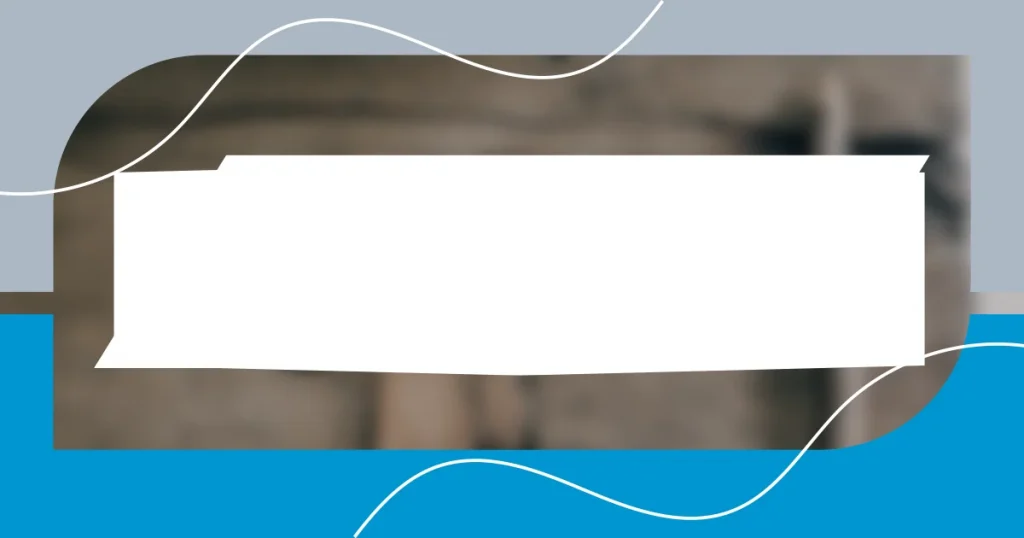Key takeaways:
- Different varnish types (oil-based, water-based, polyurethane) offer unique durability and aesthetic qualities that significantly affect the final look of a project.
- Project requirements, including durability, environmental conditions, and desired aesthetics, are crucial considerations when selecting the appropriate varnish.
- Application methods (brush, spray, wipe-on) can greatly impact the finish quality, making it essential to choose the right technique for each specific project.

Understanding varnish types
When diving into varnish types, I learned that they primarily fall into three categories: oil-based, water-based, and polyurethane. Each type not only offers a different level of durability but also impacts the final look of your project significantly. I remember when I chose my first varnish; I was amazed at how the finish could completely alter the character of my wooden pieces.
Oil-based varnishes tend to provide a warm, amber hue that deepens over time, which I personally adore for certain wood types. However, they can be a bit more challenging to work with due to their longer drying times and strong odor. Have you ever wondered why some varnishes seem to make wood come alive while others dull it down? My experience showed me that understanding the interaction between varnish and the wood species is crucial for achieving the desired effect.
On the other hand, water-based varnishes are a game changer for ease of use. They dry quickly and have low odor, making them perfect for indoor projects. I remember applying a clear water-based finish to a table I built for my living room—it allowed the natural grain of the wood to shine through beautifully without the unpleasant fumes! Each varnish type offers its own set of benefits, so it’s essential to consider the specific requirements of your project and your personal preferences as you decide.

Evaluating project requirements
Evaluating the project requirements is crucial for selecting the right varnish. I find that understanding the purpose of the finished piece greatly influences my choice. For instance, when I worked on a beautiful maple dining table, I knew it would see plenty of use, so I prioritized durability and scratch resistance. It made me realize that what’s at stake often shapes my decision-making process.
Weather conditions also play a significant role in varnish selection. I vividly remember restoring an outdoor bench, and considering its placement under a tree, I opted for a high-performance outdoor varnish to withstand the elements. Choosing a varnish that will stand the test of time is a must for outdoor projects. This experience taught me to always consider both the environmental conditions and the longevity needed for my projects.
Lastly, the desired aesthetic is a pivotal factor. I once refurbished a vintage cabinet where I had to balance the original character of the piece with modern expectations. Opting for a glossy finish transformed it beautifully while preserving its history. Every project has unique requirements, so reflecting on these aspects ensures I select a varnish that not only protects but also enhances my creations.
| Requirement | Consideration |
|---|---|
| Durability | Choose a varnish that withstands wear, especially for frequently used items. |
| Use Environment | Outdoor projects need varnishes designed to resist weather elements. |
| Aesthetic Finish | Select a varnish that complements the wood’s natural beauty and project style. |

Considering surface materials
When considering surface materials, I believe it’s essential to recognize how they interact with different varnishes. For example, when I crafted a piece using reclaimed wood, I was shocked by how the grain responded to various finishes. The texture and age of the wood influenced my varnish choice, highlighting the beauty of imperfections rather than masking them. It’s fascinating to observe how specific materials can affect everything about your project, from the hue to the sheen.
Here’s a quick list of factors to keep in mind while assessing surface materials:
- Wood Type: Different species absorb varnish differently. For instance, softer woods like pine may require more coats for optimal coverage.
- Surface Texture: Smooth surfaces often yield a sleeker finish, while rough textures can enhance grip and depth.
- Previous Finishes: If the wood has been previously treated, knowing that can dictate your varnish strategy to ensure proper adhesion and appearance.
Alongside wood, I’ve learned that metals and composites also have their own quirks. When I applied a varnish to a steel table, the protective layer not only gave it a glossy finish but also prevented rust. I realized that the right varnish truly enhances each surface material, allowing its unique qualities to shine while ensuring durability.

Assessing durability and finish
Choosing the right varnish means assessing its durability and finish carefully. I once worked on a hand-crafted coffee table that would likely see coffee rings and accidental scratches. In that situation, I knew I needed a varnish with excellent scratch resistance, so I went for a polyurethane finish. It felt reassuring knowing my choice would help protect the table from everyday wear and tear, allowing it to maintain its beauty for years.
When it comes to the finish, the gloss level truly changes the game. I remember staining a bookcase for my home office, and I wanted just the right amount of sheen—nothing too shiny that it looked artificial, but enough to catch the light beautifully. I experimented with a semi-gloss varnish, and it turned out to be a perfect balance, enhancing the wood grain while still offering a durable surface. Have you ever had a project where the finish made all the difference? I certainly have, and it’s a thrilling moment to see your vision come to life.
Durability doesn’t just hinge on scratch resistance; moisture resistance is equally critical. During a summer woodwork retreat, I crafted an outdoor table, and I realized that the constant exposure to humidity could be a real challenge. After diligent testing, I selected a varnish specifically designed to resist moisture. This experience reinforced my belief that choosing the right varnish involves a thoughtful evaluation of how the finish will stand up to the daily realities of life.

Reviewing application methods
When it comes to applying varnish, the method you choose can dramatically affect the outcome. I remember the first time I used a brush on a small table; I had no idea the bristles could leave behind streaks. This taught me that brush application, while popular, requires skill and technique to achieve a smooth finish. I quickly learned that using a foam applicator could yield a more even coat, especially on intricate surfaces. Have you ever tried different tools and found surprising results?
Spraying varnish is another method I’ve explored. I recall working on a large project—my garage shelves needed a protective layer, but the sheer size made brushing tedious. Using a spray gun not only saved me time, but it also allowed for a fine mist that left the finish flawless. The thrill of seeing it come together without the worry of brush strokes was a game-changer for me. Have you considered spraying for your larger pieces? It might just bring your work to a whole new level.
Then there’s the option of wiping varnish, which has been a favorite for smaller crafts. I vividly remember working on a wooden jewelry box and opting for a wipe-on varnish. This method gave me complete control over the saturation and drying time, helping me avoid drips and runs. Honestly, there’s something satisfying about wiping on that last coat and watching it deepen the color of the wood as it dries. Have you experienced that joy with your own projects? Each application method offers its unique benefits, and finding the right one can truly elevate your work.

Analyzing environmental factors
When I think about the environmental factors that can influence my varnish choice, one key consideration is the location of the project. For instance, I once restored a piece of furniture for a coastal home, and I quickly realized how salty air and high humidity could impact the finish. Choosing a varnish designed specifically for such conditions gave me peace of mind, knowing that it could withstand the unpredictable elements.
Temperature fluctuations also play a critical role in varnishing. I remember working in my unheated garage during a chilly winter month, where the low temperatures affected the drying time. I learned the hard way that applying varnish in less-than-ideal conditions can lead to a compromised finish, so I adapted my approach by planning projects for warmer days. Have you ever faced challenges with temperature while working on your finishes?
Finally, I can’t overlook the importance of sunlight exposure. On one occasion, I refinished a beautiful rocking chair for a friend’s patio. Realizing that prolonged UV exposure could fade the varnish, I decided to go with a UV-resistant option. It felt rewarding knowing that my decision would help protect his beloved chair from the sun’s relentless rays. Have you considered how your project’s environment could affect the longevity of your finish?

Making the final decision
Making the final decision about varnish can feel overwhelming, especially after considering various factors. I remember standing in the store, staring at countless options, questioning if I was making the right choice. It’s so easy to second-guess yourself, isn’t it? But once I weighed how different finishes would look on my project, the fog began to clear.
I recall a specific moment when I was torn between a high-gloss and satin finish for a wooden coffee table. The high gloss promised durability, but I worried it might detract from the natural beauty of the wood. After pondering how much use the table would see and how often I’d clean it, I chose satin for that warm, inviting look, and it was one of the best decisions I made. Have you found yourself in a similar dilemma, wondering which finish would truly highlight your work?
Ultimately, I’ve learned that gathering as much information as possible simplifies the decision-making process. After considering the weather, the project’s purpose, and my emotional connection to the piece, each varnish option started to take on a personality of its own. Once I made my choice, I felt an exhilarating sense of commitment. There’s nothing quite like the satisfaction of knowing you’ve selected the perfect finish for your masterpiece. What about you? How do you navigate your final decisions when varnishing?
















